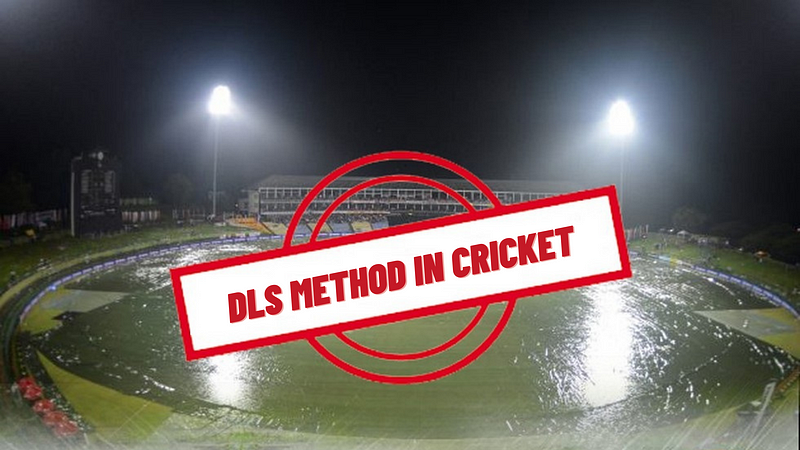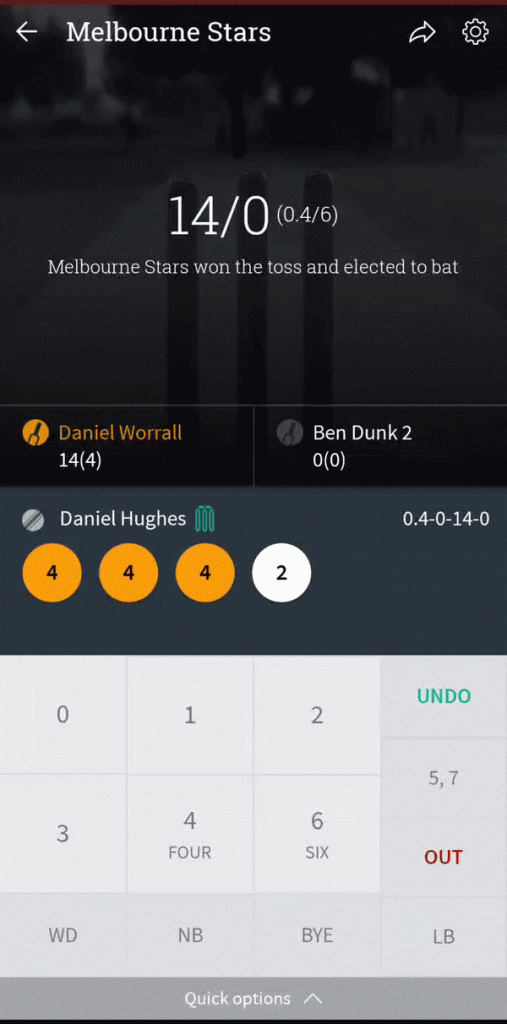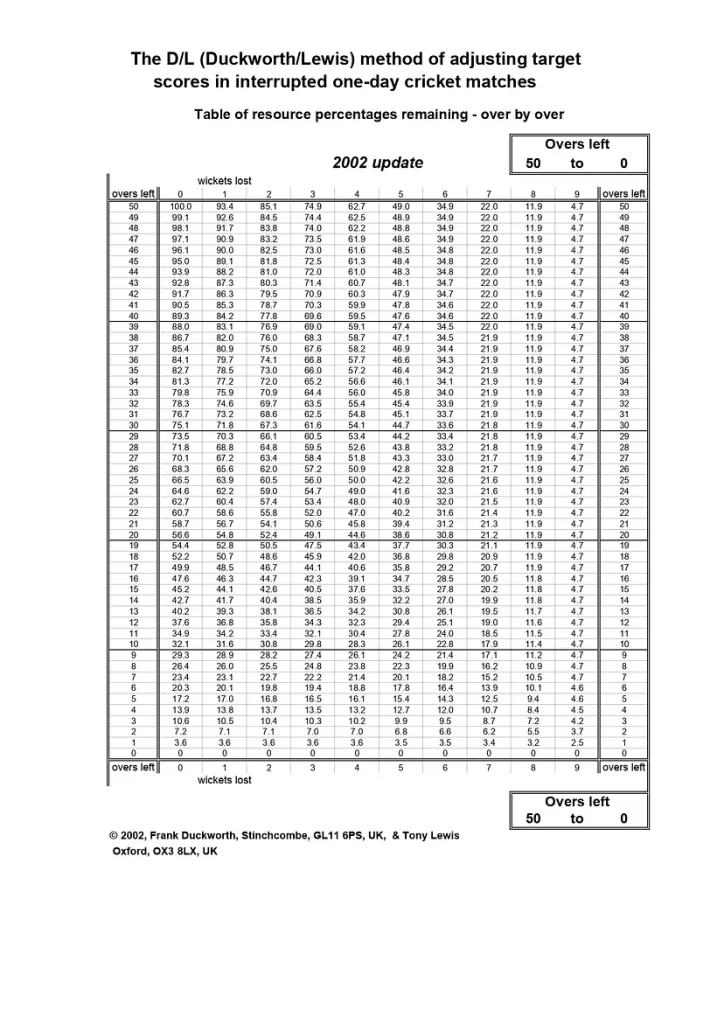Haven’t we all wondered what is this DLS method in cricket and why does it appear on rare occasions of inclement weather?

In the recent T20 Men’s world cup, the match between the cricket titans Australia and England was abandoned due to rain, which left both teams’ semi-final hopes hanging on the rope and a mass of cricket fans disheartened at the Melbourne Cricket Ground.
Making a fair decision in a rain-affected match was a big challenge for several years, especially during a limited-overs match. Earlier, the Average Run Rate (ARR) method and the Most Productive Overs’ (MPO) method was used to set the target. There were gaps in both methods as they didn’t take into account- overs lost, i.e. number of overs bowled and the number of wickets down.
Today, with the DLS method calculator in cricket, matches can reach a fair decision faster. Even in the recent world cup, the DLS method saw its application in multiple instances.
But there’s some more news–DLS calculation is a reality on the Cricheros app which needs no more than one data and you have your new target score! (More details on that when you understand the method a little better.)
What is the DLS method in cricket?
The DLS method is a mathematical formulation applied in case of rain or any undesirable circumstances that shortens the time of the match.
The Duckworth-Lewis formula was conceived by British statisticians Frank Duckworth and Tony Lewis(hence the name) and first used in 1997. ICC adopted the method officially in 1999.
Later, the Duckworth-Lewis method formula got updated by Australian academician Steve Stern who became the next custodian of the formulae. The method was renamed to its current title-DLS Method–in November 2014. So today the full form of the popular DLS method in cricket stands as the Duckworth-Lewis-Stern method.
What is the need for DLS method calculation in cricket?
International cricket matches with limited overs reserved on a certain date can’t be rescheduled to another day or the next day. The reason is simple, the logistic arrangement and expenses that go into the scheduled day are phenomenally high and rescheduling is not a viable option.
Hence, if a match is interrupted by bad weather then the full quota of overs is reduced to overs permitted for the limited time in the day. Based on the available overs, the DLS method calculator determines a revised target for the opponent team to chase.
How to calculate the DLS method in ODI cricket?
A small brief to understand how the DLS method calculator works in a one-day (50 overs) cricket match.
The DLS method calculates the runs teams must score (and would have scored) considering the situation if the resources(50 overs and 10 wickets in ODI) available to both teams were equal. And at the beginning of an innings, every team has 100% of its resources available. In DLS, the number of balls and wickets remaining at any given point is measured as a percentage.
The DLS method formula simply put:
Team 2’s par score = Team 1’s score x (Team 2’s resources/Team 1’s resources)
In international cricket tournaments, the resource values (unavailable on public forums) are added from a computer program. 1st July every year, new data is added to help the DLS evolve as scoring trends change.
But you don’t need to get into the complication of the DLS method formula.
The in-built Cricheros “Cricket DLS Method Calculator” is a standard ICC-approved V 5.0 calculator. Our customers call it an easy-to-use calculator as it requires the user to add only a single field- No. of overs to be played(resources available) and the revised target is ready on the screen.

How to use the DLS method in cricket?
In the unfortunate event of bad weather, both teams’ resources are impacted. Enters DLS method calculation. The DLS method will establish new targets based on the resources available to the two teams.
Let’s dive into four cases where DLS is applied:
Case 1- Overs lost in 1st Innings
In the ICC Men’s T20 World Cup 2022 season between Zimbabwe and South Africa;
- Zimbabwe elected to bat first
- Match delayed by rain before 1st innings commencement
- Match reduced to 9 overs per side
- Innings Break: Zimbabwe — 79/5 in 8.6 overs
- South Africa starts batting
- In the 2nd innings, it starts pouring again
- Leaving South Africa with 51/0 in 3.0 overs
- A “no result” match is declared as five overs couldn’t be bowled.
- Both teams get 1 point each
Case 2- Overs lost during the 2nd Innings
In the ICC Men’s Cricket World Cup 2019, between India and Pakistan;
- Pakistan elected to field first
- 1st Innings: India makes 300 runs in 45.4 overs as it starts raining
- Innings Break: India — 336/5 in 50.0 overs
- The rain causes a delay in the 2nd innings
- By using DLS, Pakistan is given a revised target of 302 runs.
- Wet ground and delays allow Pakistan to score 212/6 in 40 overs
- India wins the match by 89 runs against Pakistan
Case 3- Overs lost in 2nd Innings
In the ICC Men’s T20 World Cup 2022 season between India and Bangladesh;
- Bangladesh elected to field first
- India scores 184/6 in 20.0 overs in the 1st Innings
- Bangladesh starts batting and scores 66/0 in 7.0 overs before rain interrupts the match
- DLS Method is applied and the revised target for Bangladesh is 151 runs in 16 overs.
- Bangladesh scores 145/6 in 16 overs
- India wins the match by 5 runs
Case 4–Match ends in 2nd inning- Result declared
In the ICC Men’s T20 World Cup 2022 season between Ireland and England;
- England elected to field first
- Rain starts in the 1st Innings
- Ireland commences play and scores 157/10 in 19.2 overs
- England commences play in the 2nd inning
- England scores 105/5 in 14.3 overs until it starts raining
- DLS method is applied and Ireland wins the match by 5 runs
Let’s see a few more cases where DLS is applicable and not applicable.
Case 5– When 1st Innings is not played completely
1:- Overs lost before the toss
- In a 20-over match, rain starts before the toss.
- Both innings reduced to 15 overs.
- Toss happens and Team B wins the toss and elects to field first.
- Team A plays for 15 overs and Team B needs to chase the target set by Team A.
- After the completion of 1st innings, the 2nd innings is also played for 15 overs.
2:- Overs lost after a toss
- In a 20-over match, rain starts after the toss.
- Both innings reduced to 15 overs.
- Team A plays for 15 overs and Team B needs to chase the target set by Team A.
- After the completion of 1st innings, the 2nd innings is also played for 15 overs.
Case 6- Match commences with a few over (1st Inning)
1:- Overs lost
- In a 20-over match, 1st innings start as usual.
- After Team A plays for 10 overs, it starts raining.
- Team A plays for 5 more overs after the rain reduces.
- Total playing overs are reduced by 5 overs.
- Team A and Team B play for 15 overs.
2:- Inning ends
- In a 20-over match, 1st innings start as usual.
- After Team A plays for 10 overs, it starts raining heavily.
- 1st innings is reduced to 10 overs.
- In the 2nd innings, Team B also plays for 10 overs with a revise target set by the DLS method.
3:- Match ends without result.
- In a 20-over match, 1st innings start as usual.
- After Team A plays for 10 overs, it starts raining heavily.
- The match cannot be continued on the scheduled day.
- The match ends with no results.
Case 7: Rains between 1st and 2nd innings
1:- Rains but match resumes
- In a 20-over match, rain starts after the completion of 1st innings.
- After Team A plays for 20 overs, Team B will play of revised overs of 10 overs.
- Team B gets to chase a revise target by DLS calculation.
2:- Rains heavily and match is abandoned
- In a 20-over match, rain starts after the completion of 1st innings.
- Team A played 20 overs in the first innings.
- It rains heavily and the match is abandoned for the day.
- The match ends with no results.
Case 8 Rains after commencement of 2nd innings
1:- Overs reduced after rainfall
- In a 20-over match, Team A bats for 20 overs in the 1st innings.
- In the 2nd innings, rain falls after 10 overs.
- Umpire reduces the 2nd innings by 5 overs.
- By the DLS method, Team B gets 15 overs and a revised target to chase.
2:- Match stopped after the rainfall
- In a 20-over match, Team A bats for 20 overs in the 1st innings.
- In the 2nd innings, rain falls after 10 overs.
- The umpire decides to reduce the match to 10 overs.
- And the result for the match is declared by DLS calculation.
3:- Match stopped before 5 overs
- In a 20-over match, Team A bats for 20 overs in the 1st innings.
- In the 2nd innings, rain starts after 3 overs.
- To apply DLS, the minimum cover required is 5 overs.
- Hence the match ends in no results.
Note: The Cricheroes app does not have a minimum overs restriction for DLS calculation. Organizers make the call on minimum overs.
FAQs
Is Duckworth Lewis or DLS method used in T20 cricket?
Yes, the DLS method calculator is applicable for 20 overs of a T20 match. The T20 DLS method calculator takes into account 20 overs instead of 50 overs in ODI cricket. The rest of the rules for DLS method calculation is the same in T20.
What are a few important facts about how does DLS method work in cricket?
- Wickets carry higher weightage over runs scored in the DLS calculation
- Revised scores received from the DLS calculation are applied to the NRR calculation.
- The DLS method is not used in test cricket as the overs need to be static on both sides.
- The revised number of overs is determined by the umpires and match referee.
What is the DLS method sheet in cricket?
DLS method sheet means a table of resource percentages remaining — over by over. The sheet helps in adjusting target scores in interrupted limited-over cricket matches.

Does the T10 cricket league use the DLS method calculation formula?
Yes, the T10 cricket format employs the DLS method in rain-interrupted matches.
What are the minimum overs needed to apply the DLS method in ODI, T20, and T10?
ODI, T20, and T10 DLS Method Minimum Overs Required
- T10- 5 overs per side
- T20- 5 overs per side
- ODI- 20 overs per side
What happens in Dream11 when the DLS method comes into the picture?
If a match is abandoned or ends with no result, the fantasy contest is also abandoned and the entry amount is refunded to the participants.
As we said before, the DLS method calculation is a complicated one and we don’t want you to get into the cobweb when there’s no need.
Instead, you can start calculating the DLS revised target for limited-overs matches by logging into the Cricheros app. Score aaya kya?
I am Dhaval Jain, SEO All-Rounder at CricHeroes.
CricHeroes is an ultimate Cricket Scoring App and the world’s only true Cricket Network. With more than 30 million registered cricketers using CricHeroes to Live Score their Local Cricket Matches and Tournaments, CricHeroes is already the number one Cricket Scoring App in the world!










